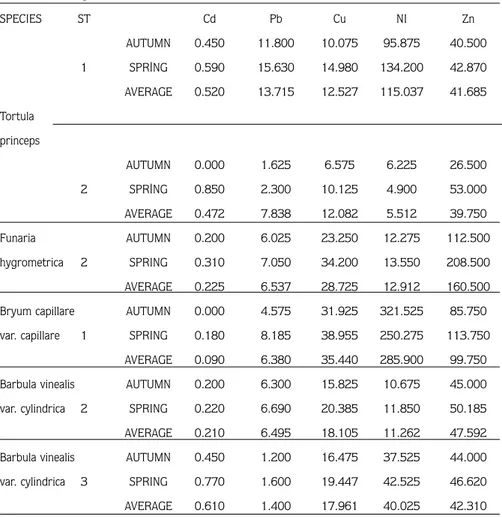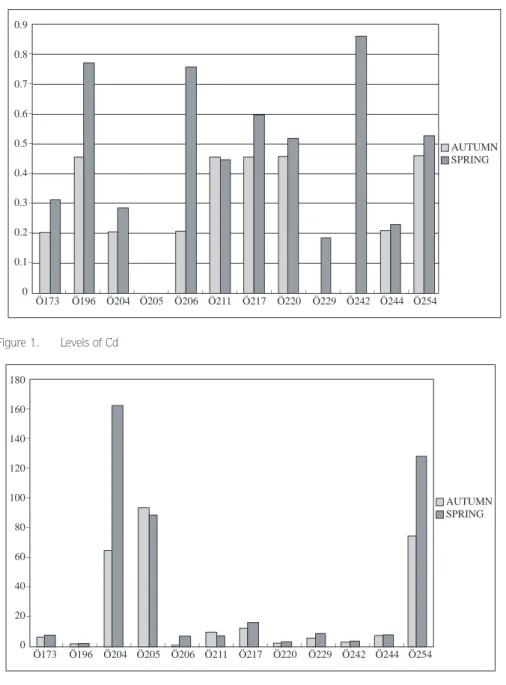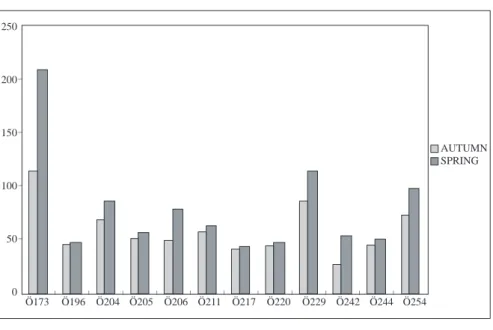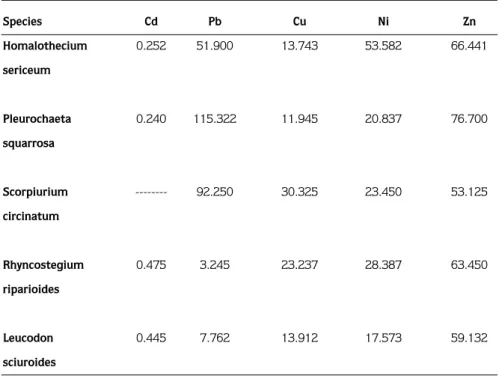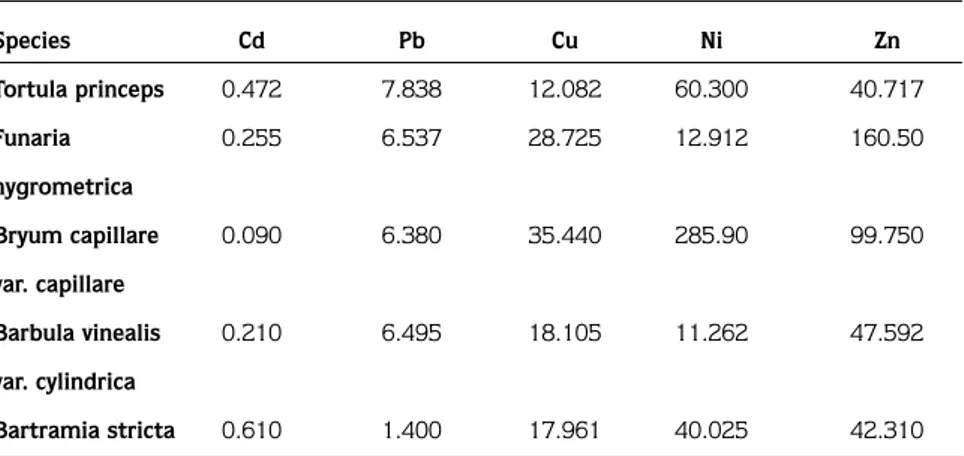Introduction
As it is known environmental problems are among daily life problems in Turkey as in the world the last 20 years. Problems such that-caused by the destruction of forests, erosion, rapid increasing of population, distorting urbanization and decreasing green areas, distortion of shores, chemicals used in industry, nuclear energy and thermic power stations are the ones that their solutions are searched not only in our country but also in all over the world. Air, water and soil pollution related to the industrialization and urbanization are above the biological tolerance limits. Especially the overlapping of the settlements and industrial areas has been the reason for increasing air pollution in recent years.
Heavy metals, such as zinc, lead, copper or nickel, are extremely toxic in very small amounts. When one or more of these elements in present in the environment at high concentrations, liv-ing organisms are subjected to strong natural selection for tolerance. Environmental contami-nation by metals exerts physological presures that are clearly too severe for survival of most species by means of phenotypicplasticity or physiological acclimation, rather than genetic adap-taion.
Mosses are used as bioindicators in some various ecological studies for recent thirty years. It is known that especially mosses and lichenes are sensible to air pollution. On the contrary to vascular plants mosses have no cuticula and epidermal layer differentiation. Carpet shaped moss-es have usually no organs for the uptake of mineral constituents from the soil, and the contact between the moss individual and its substrate mostly poorly developed. Carpet shaped mosses usually absorb minerals by their whole surface because they have no carrying systems (Rühling
22 (1998) 171-180 © TÜBİTAK
Determination of Heavy Metal Levels in Some Moss
Species Around Thermic Power Stations
Özlem TONGUÇ
Muğla University, Faculty of Science and Letters, Department of Biology, Muğla - TURKEY
Received: 27.05.1997
Abstract: In our studry, the chemical analysis related to the heavy metal pollution in some mosses
grown near the thermic power stations which built close to Muğla and its environs, was carried out. Key Words: Determination, thermic power station, moss, heavy metal, pollution.
Termik Santraller Civarındaki Bazı Karayosunlarında Ağır Metal Birikiminin Saptanması
Özet: Çalışmamızda Muğla ve civarında kurulmuş olan termik santrallerin yakınlarında bulunan
karayosunlarında kimyasal analizlerle ağır metal kirliliği tesbit edilmiştir. Anahtar Sözcükler: Tesbit, termik santral, karayosunu, ağır metal, kirlilik.
& Tyler 1973, 1984; Grodzinska & Godzik 1991). Rasmussen (1977) has already discussed
the advantages of using bryophytes for monitoring heavy metal contamination from the atmos-phere. Both bryophytes and lichenes retain heavy metals directly from precipitation, as well as from dry particulate matter, owing to their lack of cuticule and large capacity for cation exchange. According to Goncalves, Boaventura and Mouvet (1990) aquatic mosses are biologi-cal indicators; they are important bioaccumulators for pollutants and they indicate the pollution. There is a growing literature on the use of aquatic bryophytes to monitor heavy metals. Their ability to accumulate these metals coupled with the broad geographical and ecological distribu-tions of some species and their relative lack of seasonality suggest that at least in temperature regions, they have greater potential as monitors than any other group of aquatic plant. Mosses can accumulate metals without choice, they are always green, they can be picked up all year round and they have a large geographical distribution. So they are considered as ideal plants in determining heavy metal accumulation. Since they reflect the environmental pollution, mosses have been mostly used in determining pollution levels in forests, cities and industrial areas both in local and regional levels.
In this study, the research on heavy metal accumulation levels on mosses around Yatağan thermic power station near Muğla and Kemerköy and Yeniköy thermic power stations near Ören, and the research on pollution around thermic power stations and coal stock areas caused by chimney gas, ashes have been aimed.
Material and Method
The quantity of heavy metal build up on twelve kinds of mosses which collected near three termic power stations which had been built around Muğla-the area of our study-has been deter-mined. The specimens of mosses picked have been pointed by the collected number of researcher as in the following;
Ö.229... Bryum capillare var. capillare Ö.217... Tortula princeps
Ö.220... Homalothecium sericeum Ö.173... Funaria hygrometrica Ö.242... Tortula princeps
Ö.244... Barbula vinealis var. cylindrica Ö.254... Leucodon sciuroides Ö.196... Bartramia stricta Ö.204... Pleurochaeta squarrosa Ö.205... Scorpiurium circinatum Ö.206... Rhyncostegium riparioides Ö.211... Leucodon sciuroides.
They were collected in the following areas;
Ö. 229, Ö, 217, Ö. 220: Around Ören-Yeniköy thermic power station in Yeniköy.
Ö. 173, Ö. 242, Ö. 244, Ö. 254: Around the thermic power station in Yatağan and accross
Yatağan-Eskihisar coal mine.
Ö. 196, Ö. 204, Ö. 205, Ö. 206, Ö. 211: Around Ören-Kemerköy thermic power station in
Kemerköy.
Measurements made have been studied in two terms as Autumn and Spring, and their averages are presented as Table (1-2). Values of studied elements (Cu, Zn, Cd, Pb, Ni) are presented on
Figure (1-5).
Table 1. Seasonal station variables of heavy metal levels which some moss flora species were found to contain in the study area. SPECIES ST Cd Pb Cu NI Zn AUTUMN 0.450 11.800 10.075 95.875 40.500 1 SPRİNG 0.590 15.630 14.980 134.200 42.870 AVERAGE 0.520 13.715 12.527 115.037 41.685 Tortula princeps AUTUMN 0.000 1.625 6.575 6.225 26.500 2 SPRİNG 0.850 2.300 10.125 4.900 53.000 AVERAGE 0.472 7.838 12.082 5.512 39.750 Funaria AUTUMN 0.200 6.025 23.250 12.275 112.500 hygrometrica 2 SPRING 0.310 7.050 34.200 13.550 208.500 AVERAGE 0.225 6.537 28.725 12.912 160.500 Bryum capillare AUTUMN 0.000 4.575 31.925 321.525 85.750 var. capillare 1 SPRING 0.180 8.185 38.955 250.275 113.750
AVERAGE 0.090 6.380 35.440 285.900 99.750 Barbula vinealis AUTUMN 0.200 6.300 15.825 10.675 45.000 var. cylindrica 2 SPRING 0.220 6.690 20.385 11.850 50.185 AVERAGE 0.210 6.495 18.105 11.262 47.592 Barbula vinealis AUTUMN 0.450 1.200 16.475 37.525 44.000 var. cylindrica 3 SPRING 0.770 1.600 19.447 42.525 46.620 AVERAGE 0.610 1.400 17.961 40.025 42.310
Table 2. Seasonal station variables of heavy metal levels which some moss flora species were found to contain in the study area. SPECIES IST Cd Pb Cu NI Zn AUTUMN 0.200 1.250 7.925 98.175 43.250 1 SPRİNG 0.150 2..200 11.000 88.155 46.870 AVERAGE 0.175 1.725 9.402 93.165 45.000 Tortula princeps AUTUMN 0.450 74.675 17.378 12.850 73.250 2 SPRİNG 0.518 129.475 18.315 15.150 98.275 AVERAGE 0.320 102.075 17.845 14.000 85.762 Funaria AUTUMN 0.200 65.325 10.575 21.525 67.750 hygrometrica 3 SPRING 0.280 165.320 13.315 20.150 85.650 AVERAGE 0.240 115.322 11.945 20.837 76.700 Bryum capillare AUTUMN 0.000 94.650 12.325 24.050 50.000 var. capillare 3 SPRING 0.000 89.850 48.325 22.850 56.250 AVERAGE 0.000 92.250 30.325 23.450 53.125 Barbula vinealis AUTUMN 0.200 0.050 21.825 26.025 48.500 var. cylindrica 3 SPRING 0.750 6.440 24.650 30.750 78.400 AVERAGE 0.475 3.245 23.327 28.387 63.450 Barbula vinealis AUTUMN 0.450 9.025 9.900 17.725 56.500 var. cylindrica 3 SPRING 0.440 6.500 17.925 17.422 61.765 AVERAGE 0.445 7.762 13.912 17.523 59.132
Moss specimens collected from the fields and brought to laboratory have been dried in 85° C etüvs. Then a sample weighted as 1.0±0.1 grams had been put into 50 ml. erlens. 15 ml. HNO3 is pured on the sample. Next day, it is heated about 8 hours at 50°-60 °C. After cooling, 4 ml. HClO4 is added in each sample, and then heated about 4 hours at 100-110 °C. It is heated upto 190-200 °C after putting off the clocks glass on the erlens. After the precipitate at the bottom of the erlens is cooled, 10 ml. concentrated HCl and approximately 30 ml. pure water are added. Then it is again heated at 90-95 °C and the compounds are dissolved in 2-3 hours. The solution filtered by black filter paper is poured into pyrex glass ware and the pure bidestillated water is added upto the marked level. The heavy metal determination in the specimens solution that became ready to be measured after a series of chemical procedure has been read by GBC
904PBT model atomic absorbtion spectrofotometer. Cooling of floor has been obtained by using of Deterium lamp. As a result values have been counted as µg.g-1 dry weight (ppm).
Figure 1. Levels of Cd Figure 2. Levels of Pb _ _ _ _ _ _ _ _ 0.9 0.8 0.7 0.6 0.5 0.4 0.3 0.2 0.1 0 Ö173 Ö196 Ö204 Ö205 Ö206 Ö211 Ö217 Ö220 Ö229 Ö242 Ö244 Ö254 AUTUMN SPRING _ _ _ _ _ _ _ _ _ _ _ _ _ _ _ _ _ _ _ 180 160 140 120 100 80 60 40 20 0 Ö173 Ö196 Ö204 Ö205 Ö206 Ö211 Ö217 Ö220 Ö229 Ö242 Ö244 Ö254 AUTUMN SPRING _ _ _ _ _ _ _ _ _ _ _
Figure 3. Levels of Cu Figure 4. Levels of Ni _ _ _ _ _ _ 350 300 250 200 150 100 50 0 Ö173 Ö196 Ö204 Ö205 Ö206 Ö211 Ö217 Ö220 Ö229 Ö242 Ö244 Ö254 AUTUMN SPRING _ _ _ _ _ _ _ _ _ _ _ _ _ _ _ _ _ _ _ _ 50 45 40 35 30 25 20 15 10 5 0 Ö173 Ö196 Ö204 Ö205 Ö206 Ö211 Ö217 Ö220 Ö229 Ö242 Ö244 Ö254 AUTUMN SPRING _ _ _ _ _ _ _ _ _ _ _
Figure 5. Levels of Zn
Results and Discussion
As a result of our Cu and Zn values have been found very high on Funaria hygrometrica
which had been collected the area Yatağan thermic power station (Table 1-2). While Cu concen-tration value is varies between 23.250 µg.g-1 and 34.200 µg.g-1, Zn concenconcen-tration value is in between 112.500 µg.g-1 and 208.500 µg.g-1. adaptation to environmental contamination by heavy metals in cryptogramic plants is not well understood. Bryophytes occur in a diversity of metal contaminated environments including mine tailings, urban areas and on soils polluted by metal smelters, and there is some evidence that metal tolerant ecotypes occur. Increased ability to tolerate copper and zinc in Funaria hygrometrica. In contrast Shaw & Albright (1990) found no evidence that an urban population of Bryum argenteum was more tolerant of cop-per, zinc, lead or cadmium then were suburban or rural populations, although internasl concents of the metals differed greatly among them. Heavy metals, such as zinc, lead, copper, or nickel, are extremly toxic in very small amounts. When one or more of these elements is present in the environment at high concentrations, living organisms are subwected to strong natural selection for tolerance (Shaw & Albright, 1990). The use of bryophytes is a highly suitable method in assesing temporal, regional and local trends in heavy metal deposition patterns. Even
Grodzinska’s (1990) results, (Cu 6.01 µg.g-1, Zn 23.80 µg.g-1), Hylocomium splendes that
accumulates most heavy metals, are pretty low according to our study. Barbula vinealis var.
cylindrica, which was picked up around the same thermic power station, has the lowest value
_ _ _ _ 250 200 150 100 50 0 Ö173 Ö196 Ö204 Ö205 Ö206 Ö211 Ö217 Ö220 Ö229 Ö242 Ö244 Ö254 AUTUMN SPRING _ _ _ _ _ _ _ _ _ _ _
of Cd (Average 0.210 µg.g-1). The highest value has been determined in Zn as (Average 47.502 µg.g-1). However, in spring time the thermic power station, has the lowest value of Cd (Average 0.210 µg.g-1). The highest value has been determined in Zn as (Average 47.502 µg.g-1). However, in spring time the value in Homalothecium sericeum which spreads over largely, comes up to 98.275 µg.g-1. Regional variations in the concentratios of heavy metals, found in
Homalothecium sericeum in this study, reflect the fall-out from an atmospheric poll to which
long-range transport and local supply contribute. The reason for that the other species are acro-carp mosses. In Ören, Yeniköy thermic power station the lowest Cd value has been obsorved in
Bryum capillare var. capillare as average 0.09 µg.g-1. This rate is pretty low according to
Poland, Iceland and Scandinavian countries. Yearly nickel concentrations taken from thermic power station have been determined as 93.165 µg.g-1 in Homalothecium sericeum,
115.037 µg.g-1 in Tortula princeps, 285.900 µg.g-1 in Bryum capillare var. capillare.
These values has been found pretty high according to the results taken from Southern Spitsbergen (Grodzinska & Godzik, 1991).
In Ören / Kemerköy thermic power station there could be found no Cd data in Scorpiurium
circinatum. On the other hand Pb, Cu, Ni, Zn values have been found high. In the other species
similar results have been also confirmed (Table 3-4).
Table 3. According to Research Data, Annual Average Value of the Heavy Metal Concentration in Pleurocarp Mosses is Shown on the Following Table. ( µg/g Dry weight based).
Species Cd Pb Cu Ni Zn Homalothecium 0.252 51.900 13.743 53.582 66.441 sericeum Pleurochaeta 0.240 115.322 11.945 20.837 76.700 squarrosa Scorpiurium --- 92.250 30.325 23.450 53.125 circinatum Rhyncostegium 0.475 3.245 23.237 28.387 63.450 riparioides Leucodon 0.445 7.762 13.912 17.573 59.132 sciuroides
Species Heavy Metal Deposition Level Homalothecium sericeum Zn>Ni>Pb>Cu>Cd Pleurochaeta squarrosa Pb>Zn>Ni>Cu>Cd Scorpiurium circinatum Pb>Zn>Cu>Ni>Cd Rhyncostegium riparioides Zn>Ni>Cu>Pb>Cd Leucodon sciuroides Zn>Ni>Cu>Pb>Cd
As it has been already known bryophytes are seperated into two morphological groups as
Acrocarp and Pleurocarp mosses. As a result of our study as pleurocarp mosses grow
paral-lel to substratum it has been observed that they have much more ability to absorb heavy met-als. According to this the heavy metal levels of acrocarp mosses are displayed in Table 5-6.
Table 5. According to Research Data, Annual Average Value of the Heavy Metal Concentration in Acrocarp Mosses is Shown in the Following Table (Dry weight µg/g).
Species Cd Pb Cu Ni Zn Tortula princeps 0.472 7.838 12.082 60.300 40.717 Funaria 0.255 6.537 28.725 12.912 160.50 hygrometrica Bryum capillare 0.090 6.380 35.440 285.90 99.750 var. capillare Barbula vinealis 0.210 6.495 18.105 11.262 47.592 var. cylindrica Bartramia stricta 0.610 1.400 17.961 40.025 42.310
According to these results it has been observed that heavy metals cause the decreasing of the sporphyta density. Different levels of heavy metals on mosses are caused by biological and eco-logical factors such as environmental parameters and the spring time progress. Heavy metal con-centration levels in some moss species spreading largely over the area are as: Tortula princeps, Bryum capillare Ni>Zn>Cu>Pb>Cd; Funaria hygrometrica, Barbula vinealis var. cylindrica Zn>Cu>Ni>Pb>Cd; Bartramia stricta, Rhyncostegium riparioides and Leucodon sciuroides Zn>Ni>Cu>Pb>Cd; Homalothecium sericeum Zn>Ni>Pb>Cu>Cd; Pleurochaeta squarrosa Pb>Zn>Ni>Cu>Cd; Scorpiurium circinatum Pb>Zn>Cu>Ni>Cd.
Table 4. Heavy Metal Conceration Levels of Pleurocarp Mosses.
Species Heavy Metal Deposition Level Tortula princes Ni>Zn>Cu>Pb>Cd Bryum capillare var. capillare Ni>Zn>Cu>Pb>Cd Funaria hgrometrica Zn>Cu>Ni>Pb>Cd Barbula vinealis var. cylindrica Zn>Cu>Ni>Pb>Cd Bartramia stricta Zn>Ni>Cu>Pb>Cd
References
1. Goncalves, E. P. R., Boaventura, R. A. R., Mouvet, C., 1990. Sediments and Aquatic Mosses as Pollution Indicators for Heavy Metals in the Ave River Basin (Portugal). The Science of the Total Environment, 114: 7-24.
2. Grodzinska, K., Szarek, G., Godzık, B., 1990. Heavy Metal Deposition in Polish National Parks-changes during ten years-Water, Air and Soil Pollition 49: 409-419.
3. Grodzinska, K., Godzık, B., 1991. Heavy Metal and Sulphur In Mosses From Southern Spitsbergen. Polar Research 9(2): 133-140.
4. Rasmussen, L., 1977. Epiphytic Bryophytes As Indicators of the Changes In The Back Ground Levels of Airborne Metals From 1951-1975. environmental Pollution 14: 37-45.
5. Rühling, A, Tyler, G., 1973. Heavy Metal Deposition in Scandanavia. Water, Air and Soil Pollution 2, 445-455. 6. Rühling, A, Tyler, G., 1984. Recent Changes in the Deposition of Heavy Metals in Northern Europe. Water, Air and
Soil Pollution 22, 173-180.
7. Shaw, A. J., Albright, D. L., 1990. Potential for The Evolution of Heavy Metal Tolerances in Bryum argenteum a Moss. II. Generalized Tolerances Among Diverse Populations. The Bryologist 93(2): 187-192.
Table 6. Heavy Metal Concenration Levels of Acrocarp Mosses.
